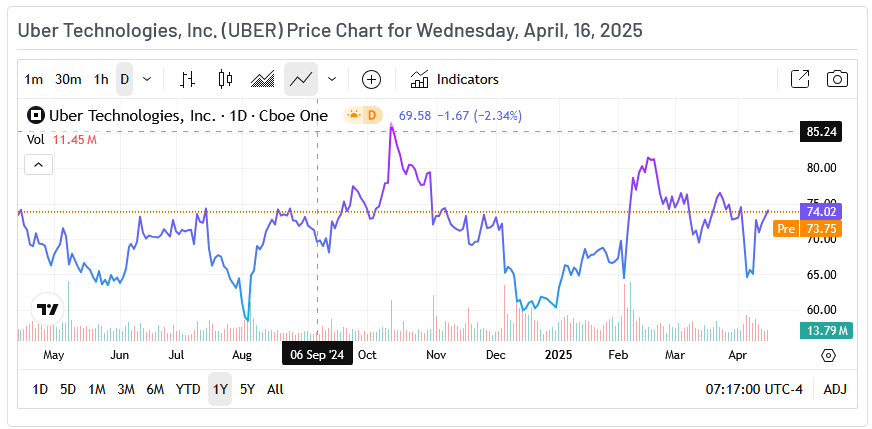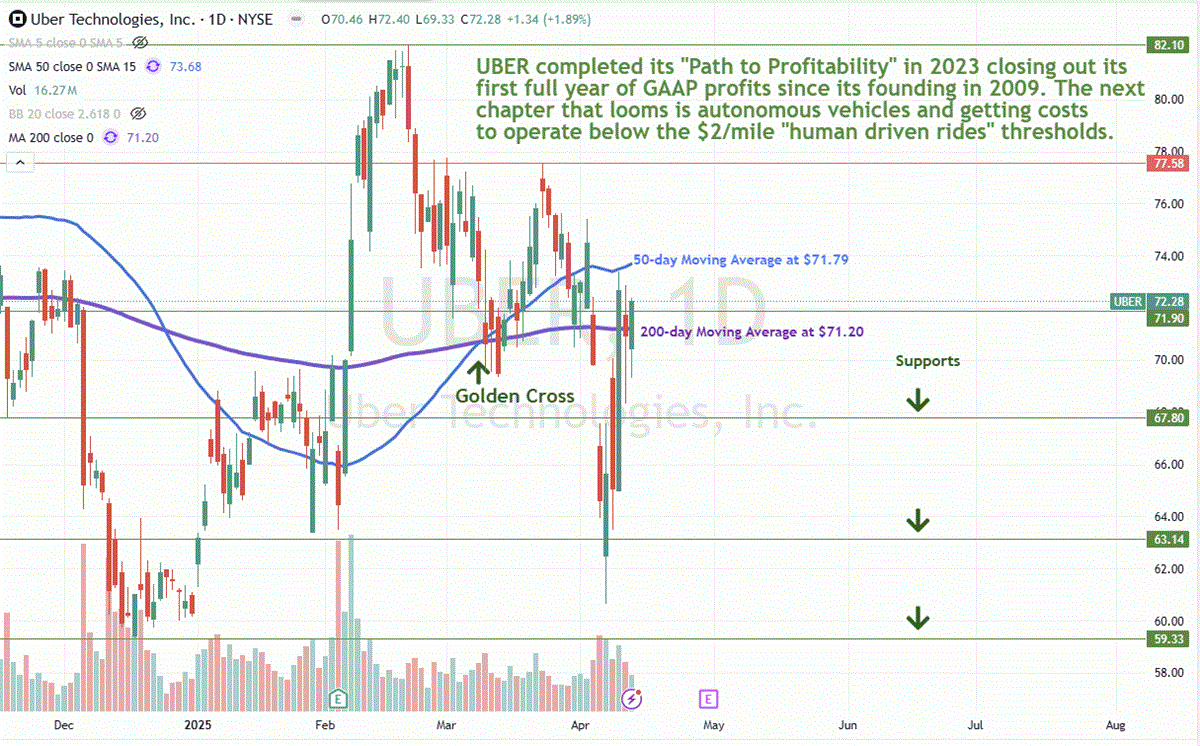Why Uber’s Stock Could Soar on AV Growth and Tariff Resilience
MarketBeat.com | Apr 16, 2025 07:20AM ET
The wild market volatility being driven by Trump tariffs and trade wars has caused many fundamentally strong stocks to get dumped along with the weak ones. This indiscriminate and disjointed selling always presents opportunities to get in on strong companies at lower prices.
One such company is the undisputed rideshare leader Uber Technologies (NYSE:UBER).
Coming off its first year of GAAP profitability reached in 2023, Uber scaled its operating profits by 152% to $2.8 billion in 2024, generating $6.9 billion in free cash flow with 18% year-over-year (YOY) revenue growth trading at a modest price-to-earnings (P/E) ratio of just 15.8x, as of April 11, 2025.
This falls well below the average P/E of 25.2x in the computer and technology sector and Uber's three-year average P/E of 64.1x. As for tariffs, investors need not worry about direct impacts since Uber doesn’t manufacture or import products.
Could Tariffs Hurt Uber Indirectly? Yes, and Everyone Else Too
Tariffs can reduce disposable income and dampen consumer spending, which spells trouble not only for Uber but for all service-based businesses.
If tariffs fuel inflation and force consumers to cut back on discretionary spending, Uber could see a decline in ride requests and food delivery orders.
Since Uber drivers are responsible for providing and maintaining their own vehicles, tariffs on automobiles could hit them especially hard. Higher prices for new cars may prompt drivers to keep their older vehicles longer. If maintenance and repair costs rise—whether due to tariffs on parts or increased usage—drivers may either delay necessary repairs or incur extra costs to stay on the road.
Both outcomes could degrade the quality of Uber’s service.
In a worst-case scenario, some drivers may choose to quit altogether in search of better economic opportunities. This would shrink Uber’s driver pool, reduce ride availability for passengers, and ultimately cut into the company’s bottom line.
From Elusive Profitability in 2023 to Scalable Growth in 2024
It took more than 14 years and over $30 billion dollars in accumulated losses for Uber to finally complete its path to GAAP profitability in 2023. And in 2024 Uber proved it could not only sustain profitability but also scale it.

While Uber technically hit GAAP profitability in Q2 2023, it was largely due to a $384 million pre-tax benefit from unrealized gains related to its equity investments, like Grab Holdings (NASDAQ:GRAB).
Uber’s P/E ratio was 66x by the end of 2023 and peaked at 111.6x in March 2024. It has since dropped under 16x as of April 11, 2025.
Uber is also the dominant player in the rideshare duopoly, with Lyft Inc (NASDAQ:LYFT). NASDAQ: LYFT commanding a 76% market share.
Margin Expansion Continued in 2024
Uber’s gross margin expanded 48 bps YOY to 39.51% in Q4 2024.
Uber also uses a revenue margin metric for its two segments: Mobility (Uber rides) and Delivery (Uber Eats). This indicates what Uber keeps from bookings before expenses like driver incentives and insurance. Its Mobility margin gained 160 bps to 30.3%, and Delivery gained 40 bps to 18.7%.
Gross bookings rose 18% YOY in both Mobility and Delivery to $44.2 billion. Uber grew its Uber One membership program by 60% YOY to 30 million subscribers.

Is More Growth Coming in 2025?
Looking forward to Q1 2025, Uber issued guidance for gross bookings growth of 17% to 21%, with a midpoint of 19%. It translates into $42 billion to $43.5 billion, with a midpoint of $42.75 billion. This was a sequential drop from the 21% reported in Q4 2024, primarily due to impacts from the Los Angeles wildfires and forex.
Uber expects Q1 2025 adjusted earnings-before-interest-taxes-depreciation-and-amortization (EBITDA) to grow 30% to 37% YOY, with a midpoint of 34% of $1.79 billion to $1.89 billion, with a midpoint of $1.84 billion.
“Uber ended 2024 with our strongest quarter ever, as growth accelerated across MAPCs, trips, and Gross Bookings. Our performance has been powered by rapid innovation and execution across multiple priorities, including the massive opportunity presented by autonomous vehicles (AVs)," said CEO Dara Khosrowshahi.
Activist investor Bill Ackman posted on X that his Pershing Square accumulated 33.3 million shares of Uber starting in January 2025. This, combined with a post-earnings rebound, led shares of UBER to spike to a 52-week high of $82.10 in the following weeks.
Uber's Next Frontier? Autonomous Vehicles
Throughout Uber’s Q4 presentation, conference call, and television appearances, Khosrowshahi was adamant about the $1 trillion AV opportunity in the United States.
Uber has teamed up with Alphabet (NASDAQ:GOOGL) owned Waymo to provide a robotaxi service in Austin, Texas and Atlanta, Georgia. The company formed a similar deal with WeRide Inc. NASDAQ: WRD to offer WeRide AVs on the Uber platform in Abu Dhabi.
Uber Getting Its Feet Wet with the Asset-Light Robotaxi Model
Instead of investing heavily in its own AVs, Uber is leveraging its massive distribution network of more than 170 million riders worldwide to partner with robotaxi operators in an asset-light model to facilitate rides.
Bloomberg reported that Waymo robotaxis made up 20% of Uber’s rides in Austin during the last week of March 2025. This was at a rate of 80% higher than Waymo’s rollout in San Francisco, primarily due to being Waymo trips offered on the Uber app.
Uber proved that Waymo could get way more rides on Uber’s platform. This underscores the win-win proposition for having Waymo available on the Uber app and the asset-light model for Uber to get a piece of the robotaxi action. Uber is not providing its own autonomous rides or robotaxi rides, just offering access to its network of passengers and taking a cut of the fare from Waymo. As such, it doesn’t bear the expenses and maintenance for the self-driving vehicles either.
Uber gets to collect all the data in the process and generate an additional stream of revenues. This could be their inroad into the AV market, before it considers going all in with their own fleets in the future.
Trading in financial instruments and/or cryptocurrencies involves high risks including the risk of losing some, or all, of your investment amount, and may not be suitable for all investors. Prices of cryptocurrencies are extremely volatile and may be affected by external factors such as financial, regulatory or political events. Trading on margin increases the financial risks.
Before deciding to trade in financial instrument or cryptocurrencies you should be fully informed of the risks and costs associated with trading the financial markets, carefully consider your investment objectives, level of experience, and risk appetite, and seek professional advice where needed.
Fusion Media would like to remind you that the data contained in this website is not necessarily real-time nor accurate. The data and prices on the website are not necessarily provided by any market or exchange, but may be provided by market makers, and so prices may not be accurate and may differ from the actual price at any given market, meaning prices are indicative and not appropriate for trading purposes. Fusion Media and any provider of the data contained in this website will not accept liability for any loss or damage as a result of your trading, or your reliance on the information contained within this website.
It is prohibited to use, store, reproduce, display, modify, transmit or distribute the data contained in this website without the explicit prior written permission of Fusion Media and/or the data provider. All intellectual property rights are reserved by the providers and/or the exchange providing the data contained in this website.
Fusion Media may be compensated by the advertisers that appear on the website, based on your interaction with the advertisements or advertisers.